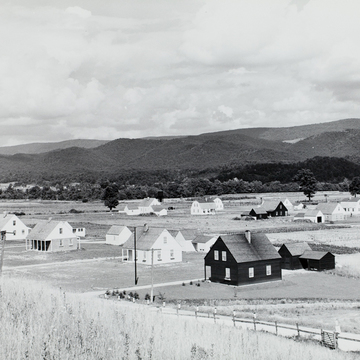The announcement that Tygart's Valley would be the site of the second of West Virginia's three WPA subsistence homestead projects was made on December 22, 1933. The largest of all, the project was established on more than 2,000 acres of former farmland, portions of which were divided into 195 homestead tracts averaging 1.72 acres. Although smaller than the plots at Arthurdale in Preston County, they still provided room for each family to have a house, barn/garage, coal bin, chicken coop, root cellar, and garden. The remaining land was held in common for woodlots and pastures.
There were two clusters of houses: an informally arranged group on the west side of the highway at Dailey, ten miles south of Elkins, and a larger group east of the highway at Valley Bend, two miles farther to the southwest. At Valley Bend, streets were arranged in a grid pattern. Initial construction began in March 1934, with preselected future homesteaders doing much of the work. The first settlers moved in on February 11, 1935. Later that year, Camp Tygart was established near Dailey, and the CCC cadets housed there participated in later phases of construction.
Costs ranged from $2,800 to $3,500, depending on lot size and on which of eight available models homesteaders chose. Houses, which followed designs based on those that architect Steward Wagner had already provided for
Washington officials justified Randolph County for the homestead project because 71 percent of its population was on relief rolls during the depths of the Depression. Homesteaders were selected from three of the county's hardest-hit occupational groups: coal miners, lumber industry workers, and farmers living on what were considered “submarginal” lands. At the time, the once-extensive Randolph County lumber industry was all but moribund, but planners expected that employment opportunities related to the Monongahela National Forest, which already encompassed more than 700,000 acres, would develop. In addition, the Tygart's Valley Association was created to help the homesteaders find employment. As at other subsistence projects, schools were an important part of the package. The Homestead School, established in 1939, replaced a halfdozen one-room schools in the area.
By 1941 the association's major enterprise was a lumber mill, designed to cut “half the annual output of the Monongahela National Forest.” In 1944 the association was terminated, and in August 1946, the sawmill and other commercial property were sold at auction. The 195 homesteads were sold in the remaining months of 1946 and during 1947, mostly to residents.
Most of the houses remain in good condition, although modifications and additions have altered the original designs over the years. A number of outbuildings, notably the semiexposed root cellars attached to small garages in side or rear yards, also remain. The former Community Building, the largest structure of the complex, now contains a post office and restaurant.





